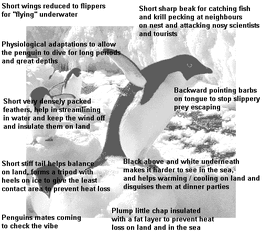According to Webster (2000), "adaptation is the fit between the design of an organism and its habitat" (p. 28). Adaptations are any behavioral or physical characteristics of an animal that helps it to survive and thrive in its environment.
Physical Adaptation
A physical adaption involves evolutionary changes that are made to the body which helps improves that species' chance of survival in its current environment. They consists of adaptation to body parts such as the presence as webbed feet, sharp claws, hollow bones; or changes to body coverings such as stripped fur, brightly colored feathers or thick scales (Zoological Society of Milwaukee, 2013). Each adaptation allows each animal that possess them a high

er chance of survival because they allow for specialized skills such as swimming or camouflage. Other examples of physical adaptations can include the streamline shape of a fish's body to cope with its aquatic environment or the presence of fat in a camel's hump that allows it to survive in a desert environment without water for several days (Webster, 2000).
Behavioral Adaptaion
A behavioral adaptation involves a change in the actions of an animal that helps increases its chances of survival in a particular environment (Zoological Society of Milwaukee, 2013). The way a

Bottlenose Dolphin Mudflat Hunting
In a strange hunting technique, Bottlenose Dolphins in Georgia and South Carolina waters not only drive fish ashore but throw themselves onto land to collect prey.One of many Techniques Dolphins utilize when Hunting.
n animal responds to environmental stimuli can lead to behavioral adaptations like birds flying south for winter or bears hibernating when food is scarce. These actions gives the animal a better chance of survival when the environment around them becomes harsher. An animal's hunting or foraging skills are another example of behavioral adaptations. Those that have poor feeding skills will likely die off while those who are better at hunting are more likely to pass on their genes to future generations (Webster, 2000). This can be seen in the incredible behavioral adaptation that are seen in a group of dolphins living in the tidal marshes of Georgia. At low tide, this dolphin pod has actually developed a way to fish for prey in water that are only inches deep (Strege, 2013)! This behavioral adaptation gives these dolphins a much higher chance of survival.
REFERENCES:
Campbell and Reece. Biology. Chpt. 24: Species and Speciation.
Strege, D. (2013). Dolphins fish on land in incredible wildlife display. Retrieved from: http://www.grindtv.com/outdoor/nature/post/dolphins-fish-on-land-in-incredible-wildlife-display/
Webster, S. (2000). The Kingfisher book to Evolution: Basics for evolution pp. 22-36.
Zoological Society of Milwaukee. (2013). Animal Adaptations. Teacher's Guide. Retrieved from: www.zoosociety.org/pdf/GuidedTours/AnimalAdap.pdf